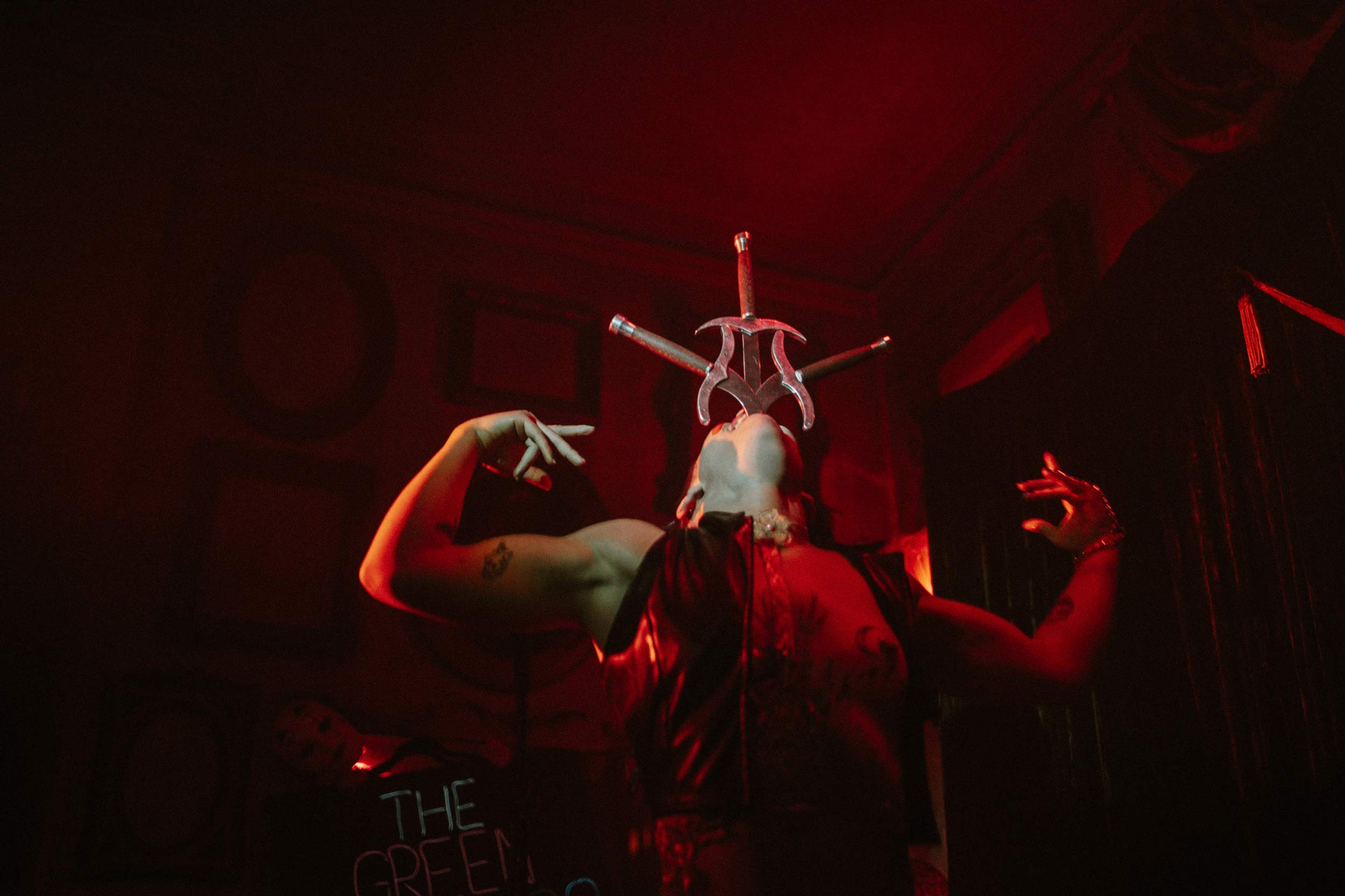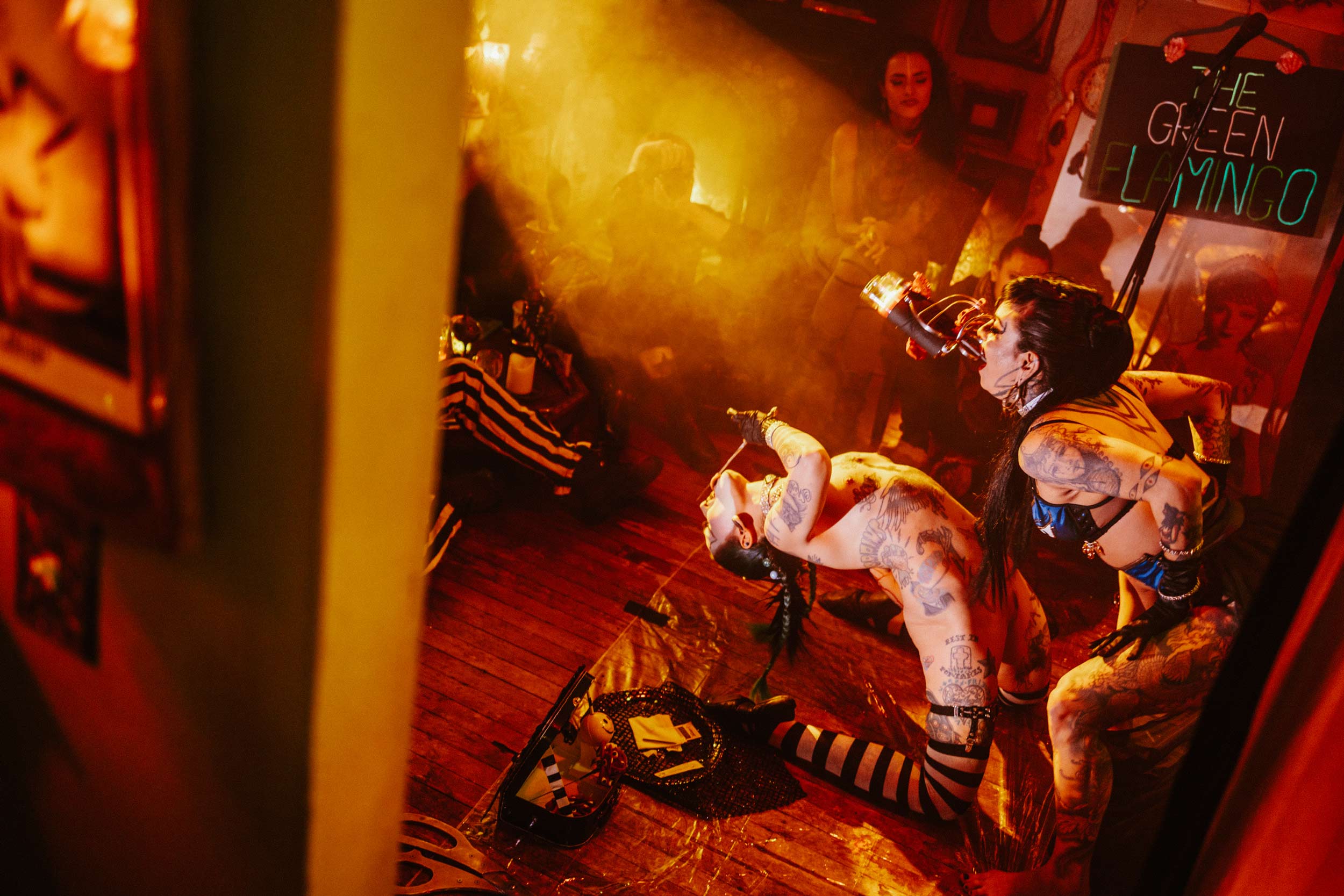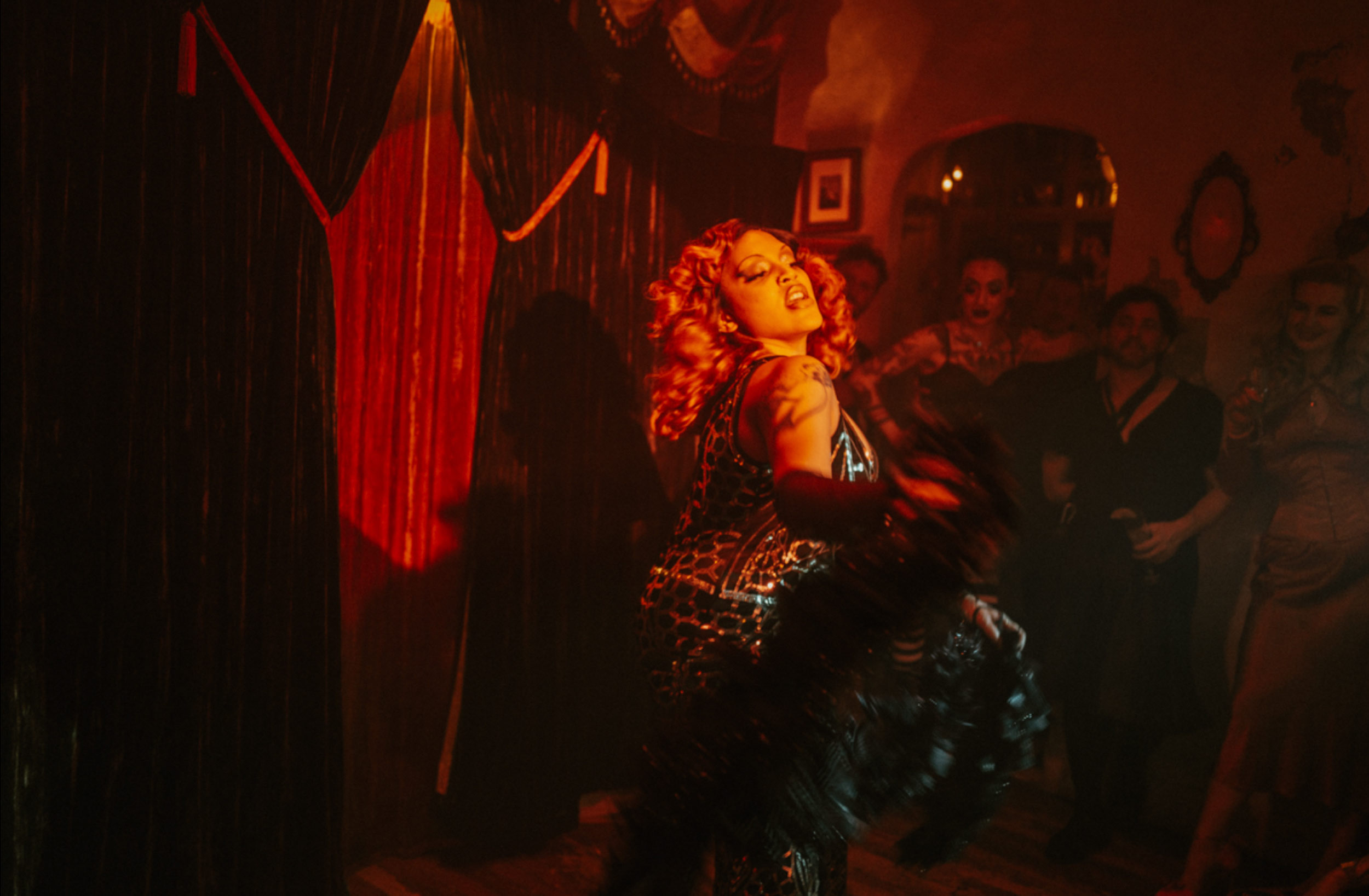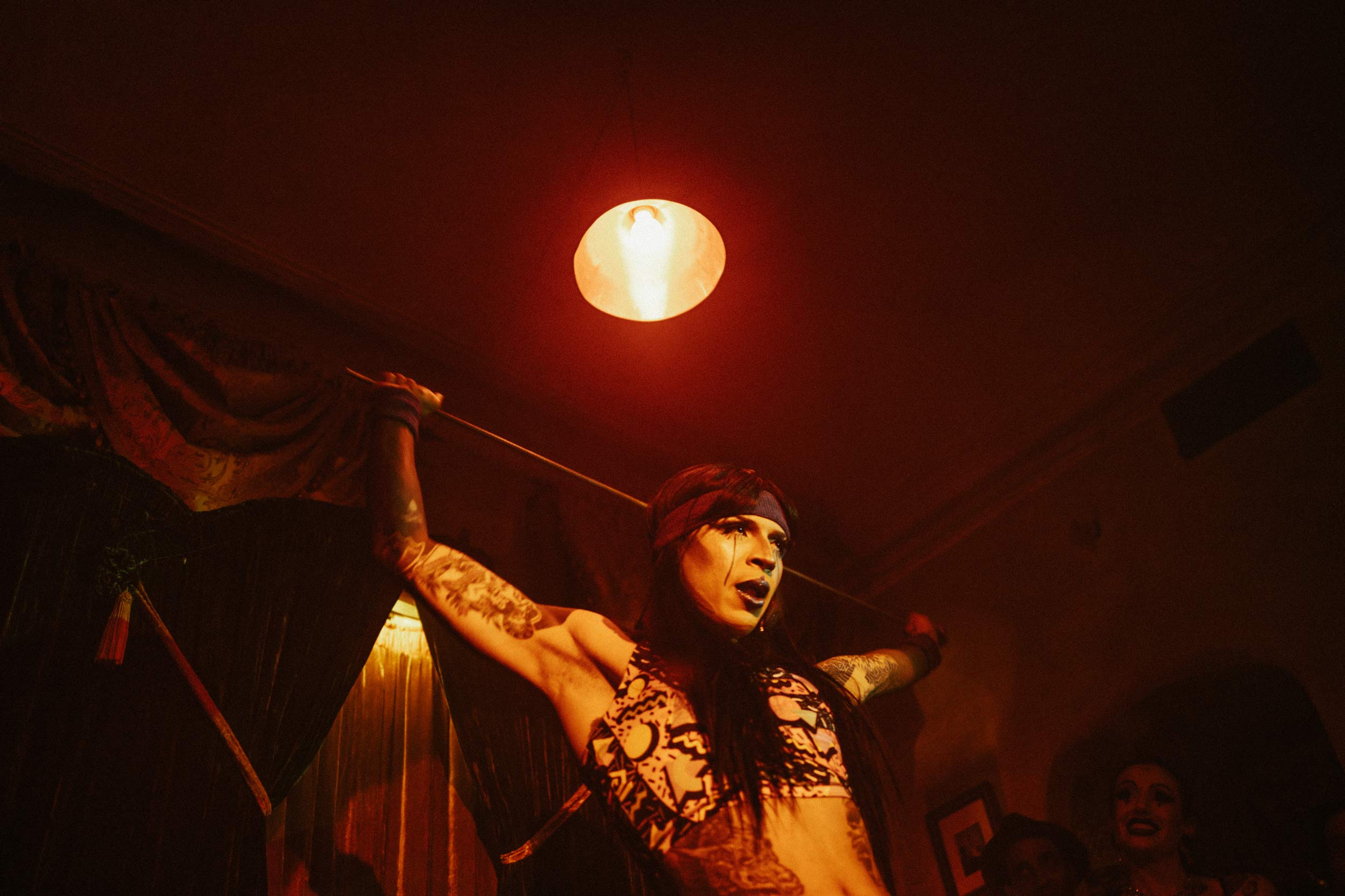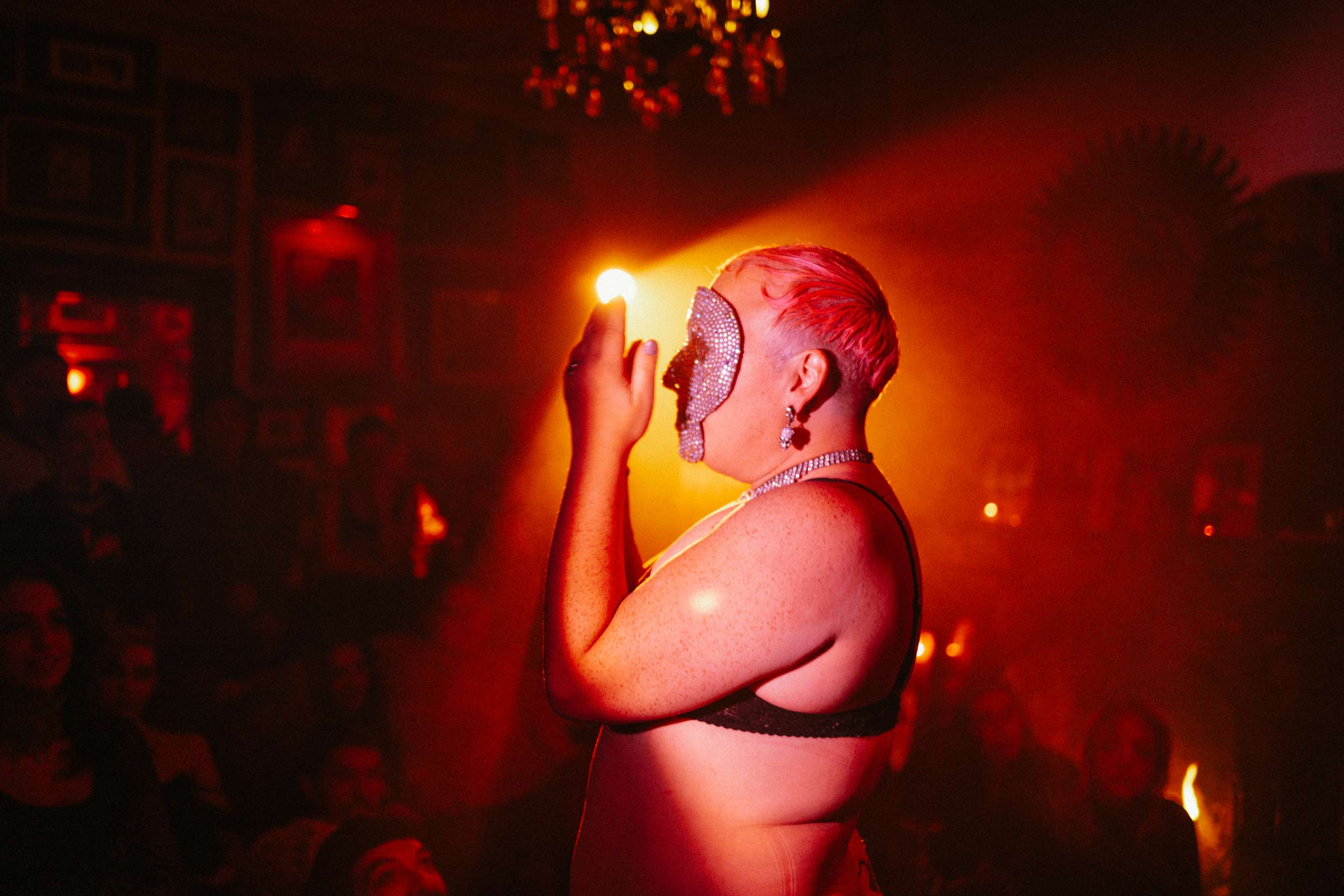Inside the clandestine parties keeping the creative spirit of the space alive, decades after its illustrious heydey
The Chelsea Hotel has long served as a haven to artists, misfits and outsiders—from its roots as a socialist commune, to its heyday as the center of countercultural activity in New York. “There was a tradition of tolerance built into its bones,” wrote Sherill Tippins in Inside the Dream Palace. “The more outside of mainstream society you were, the more inside you would be at the Chelsea.”
This legacy dates back to the 1880s, when architect Philip Hubert conceived of the 12-floor Victorian building not as a hotel, but a radical experiment in communal living—drawing inspiration from the teachings of Charles Fourier, a French philosopher who aimed to create a model of society that bridged class divides while championing the arts, culture, and freedom of sexual expression. Years later, it landed in the hands of the Bard family, who tended to the needs of its residents for over 40 years—during which time it came to be known as a bohemian sanctuary populated by cultural luminaries like Patti Smith, Allen Ginsberg, Thomas Wolfe, and Robert Mapplethorpe. Today, all but a few of the building’s 400-some units have been freshly renovated, the homes of artists repurposed as luxury accommodations for photoshoots, fans of old New York, and even families on vacation. But on the sixth floor, in Tony Notarberardino’s apartment, that spirit of radical creativity lives on.
When Notarberardino first stumbled through the hotel’s doors in 1994, he was fresh off a flight from Melbourne, and just looking for a place to spend the night. But the hotel manager, Stanley Bard—a shrewd, “magician-like” figure known for hand-curating the hotel’s residents—had other intentions for him. “Australian, huh?” he said, looking Notarberardino up and down. “I have just the thing.”
Bard led him up six flights of stairs, and into a suite formerly occupied by the fellow Australian Vali Myers—a famous artist, dancer, and bohemian who served as a muse to the likes of Diane Arbus, Debbie Harry, and Patti Smith. It was 6:30 in the morning, and dawn was just breaking over the Chelsea sign. Notarberardino remembers experiencing a profound sense of déjà vu—or maybe that was just the jetlag setting in. He struck a deal with Bard, who handed over the keys and headed for the door. Then he paused, and turned to Notarberardino with a knowing smile before saying, “You know, you may never leave this place.”
He never did.
Notarberardino’s door, with its peeling paint and palpable flair, stands out against its nearly-renovated neighbors—so much so that, now that the Chelsea’s open, strangers sometimes wander in and attempt to take a look. And you can’t blame them: “It’s like another world,” says Alaska, a sideshow performer who frequents Notarberardino’s parties “The first time I walked in the door, I immediately felt at home. There was this sense of, Oh, I can just exist here.”
Once described as “the lair of a well-traveled, horny Victorian” by the writer Legs McNeil, Notarberardino’s apartment is suffused with an Old World glamor that captures the imagination. The walls are covered with ornate murals, antique mirrors, and empty picture frames. An opulent crystal chandelier rests on the worn wood floor, alongside Russian oil lamps, votive candles, sculptures of religious figures, a stuffed elk head, and a pair of glossy black Pleasers: the brand of heels favored by many of the burlesque performers, drag queens, and sideshow performers who have come to consider his living room their second home.
Notarberardino has always had a fondness for self-proclaimed “perverts and freaks”: From artists and eccentrics to strippers, dominatrixes, and circus performers. It’s part of why, as the Chelsea’s unofficial portraitist, he’s spent the past three decades documenting the characters who pass through the hotel—capturing everyone from cultural luminaries like Grace Jones, Arthur C. Clark, and Sam Shepard, to the transients, drug dealers, and sex workers who once walked its halls.
I became friends with Notarberardino in 2018, when the empty halls of the Chelsea were covered in dust and plastic wrap—a renovation that had been in progress for years, leaving the hotel in a state of half-inhabited limbo. Only a handful of permanent residents remained: longtime fixtures like Notarberardino and the nightlife legend Susanne Bartsch, with whom he sometimes hosts large events. But usually, his parties are an intimate affair: 20 or 30 people crowded together on the velvet couch or worn wood floor, waiting for the show to begin.
The performances take place in Notarberardino’s dimly-lit living room, in front of a set of green velvet curtains that once served as a funeral photographer’s backdrop. There, in the mesmerizing glare of the spotlight, I’ve seen people conduct bloodletting rituals; pierce one another’s bodies with fish hooks and swallow swords; or else, simply indulge the audience in a striptease, baring it all in front of friends and lovers. Often, Notarberardino’s parties are still raging by the time the sun starts to rise, flooding the apartment with hazy light—at which point he can be found in the kitchen, uncorking a final, secret bottle of champagne for the after-hours crowd, many of whom stay on for days after the party’s end.
Now that the Chelsea plays host to paying guests—many of whom are happy to fork over hundreds a night to experience a slice of the hotel’s illustrious history—it’s hard to imagine the subcultural activity for which it was once known would continue to thrive. But pockets of it still exist, fostered by permanent residents like Notarberardino, who has been welcoming performers into his home for over ten years. The gatherings are exclusive, limited mostly to members of New York’s queer nightlife scene who—after spending their nights on public stages all around the city—congregate at the Chelsea, where they do it all again, this time for their fellow performers. “Not everyone knows how to cultivate and protect the energy of a space like this—so if you’re here, that means someone trusted you enough to welcome you in,” says Jack Rabbit Slims, a burlesque dancer who started her career in Notarberardino’s apartment six years ago. “Because of that, there’s this sense that everyone in the room is meant to be here.”
Anna Monoxide, a pillar of the Chelsea’s creative community, credits the supportive environment with helping her reach new frontiers as a performer. “Everyone here loves to watch someone do something for the first time, so that really encourages you to experiment and push the boundaries of your art,” she says. “My career really took off after I met Tony.”
When Monoxide started performing here eight years ago, she was just a pincushion performer—which, she says with a grin, is pretty much what it sounds like: “Lots of needles in different parts of the body.” Now, she’s expanded her repertoire to include balloon-swallowing, hot wax pouring, and human blockhead, in which she nails sharp objects into her nostrils. She also bends rods of steel rebar with her body, leaving ghostly bruises in their wake, alongside a rotating assortment of scars and scabs from her pincushion acts. (“Am I a masochist? I don’t think so,” Monoxide once mused, as she helped me test my tolerance for pain on a bed of nails she’d had custom-made. “I wouldn’t do this without an audience.”)
The first time I saw Monoxide perform, she was nearly naked: clothed only in a latex nun habit, full-face clown makeup, striped thigh-highs, a cross-emblazoned thong, and soon, her own blood. Swaying to the tune of Depeche Mode’s “Personal Jesus,” she pushed a foot-long medical needle through her tattooed skin. First, her forehead—where, if you squint, you can see the faint scar of a X she once carved into her skin onstage; then, her left breast, timed to the song’s lyrics. “Things on your chest you need to confess I will deliver / You know I’m a forgiver.”
Monoxide teases her audience, miming exertion as she struggles to push the needle through the flesh of her breast. Moments later, it exits on the other side; the crowd cheers, and blood begins to trickle down her bare ribcage onto the floor, where she’s carefully laid a tarp to contain the biohazard. Later, she will pierce the soft flesh of her mons pubis, and pull a crucifix out of her vagina, presenting it to a friend as a birthday gift. An hour or two after that, she will lounge in the living room in a fluffy robe and slippers, having cleaned and dressed her wounds with a practiced ease. At one point, Monoxide was piercing herself up to eight times a week for paying audiences—but it’s the end of the pandemic, and for the moment, she has no scars.
Monoxide is the first to admit she doesn’t have the same relationship to pain as other people—but in her view, that’s not what performing is about. It’s art, and her body is just an instrument, which itself is part of an ancient tradition that extends long before her birth. In addition to serving as a spiritual practice, sideshow has given Monoxide a new level of appreciation for her own physical resilience, having sustained a debilitating back injury in 2016—which you wouldn’t know, had you seen her do the splits on that same bed of nails. “I’m turning 40 next year,” she says, “and being able to do the things I do gives me a lot of joy.”
Monoxide’s other performances are no less extreme. I once witnessed her blow up a three-foot-long balloon, then swallow it whole—and found myself biting my tongue in an attempt to contain my questions about how, exactly, this was possible. It’s a common experience: “People constantly think what we’re doing is fake,” Monoxide says, describing how she goes to great lengths to illustrate the physical factors involved—yet still encounters those who believe she’s piercing fake skin, or that the bed of nails isn’t really sharp, or that the hot wax she’s pouring on her body doesn’t burn. “I think it’s because, if someone can’t imagine themselves doing it, they’re like, That’s impossible,” Monoxide says. “But that’s what sideshow’s all about: It’s the process of training your body to do impossible things.”
When I text Monoxide to fact-check this piece, she’s at a convention in Poland dedicated to hook suspension: The act of rigging a human body to hang from piercings in the skin, and which has historically been practiced by a range of cultures around the world. She quickly responds to my questions, and sends along a few selfies, too: her with a silver brochette through her face, entering one cheek and exiting the other; two large hooks in her ribs, and one through her chest. “I’ll tell you all about it,” she promises. “I wore the cheek skewer for hours.”
The first time Monoxide walked into the Chelsea, she recalls being surprised there was no stage. “But then, watching people perform, you realize you don’t need it,” she says. “It’s intimate. It’s magical. And if you look closely, you can see that, on the part of the floor that becomes the stage, the wood is worn because so many things have happened right there. Performing at the Chelsea is like feeding the spirits so that the magic of the place can stay alive.”
For many, an enthusiastic audience is not just a perk, but a necessary part of the ritual. “At the Chelsea, there is a very real sense of love and connection that we’re sharing. I’ve performed things here that are so physically challenging I can’t even practice them at home—I need the energy of the crowd to be able to reach those limits,” says burlesque performer Lola Strange, who I once watched affix hundreds of clothespins to their body, from her nipples to her labia to, eventually, her face—dancing and grinning all the while. It was just after sunrise, and she had missed most of the party, having spent the night onstage entertaining strangers—but she still wanted to deliver something that would delight and titillate those who remained. “In the outside world, it’s challenging to share that type of art,” she explains. “So it’s really special to share in a very intimate space with people who are already so open to what we are doing.”
That’s not to say people don’t sometimes get squeamish. One night, two people fainted simultaneously during a bloodletting ritual—a performance that culminated with one performer squirting into the other’s mouth like a baptism. Such events are not entirely par for the course, but they’re also not unexpected: “Everyone in the room knows they’re in for something weird, something they can really sink their teeth into,” says burlesque performer and drag king C’était BonTemps. “The Chelsea has become this safe haven. You can really do anything you want, and as a performer, that gives you freedom.”
Allie Saint Surreal, a sideshow performer and drag queen who started their career in Notarberadino’s living room, echoes this statement: “It’s a community of people who are all here to enjoy each other and be supportive, not just a room of people who paid a ticket to see something entertaining. That allowed me to slowly come out of my shell, and experiment with new forms of gender expression,” they say. “Out of drag, I’m a very masc-presenting nonbinary person who goes by they/them; I don’t know exactly what it is to ‘look’ nonbinary, and I don’t want to have to walk around with a name tag. But with performance, you get to present exactly what you want to present; you’re like, This is my gender identity. This is how I want to be perceived.”
For Veronica Viper, the unique atmosphere is a welcome respite from performing for outside audiences—many of whom may never have seen a trans person before, much less a trans person performing a strip tease. “I make a point to perform in venues that don’t often see women like me. It’s important to be visible with all that’s going on right now—and as a trans person, my performance gives me a moment to control what message the audience receives about who I am,” she says. “Drag and burlesque are the same in that sense; in drag, you put layers on to reveal your true self. And in burlesque, you take layers off to reveal your true self—but the underlying message is the same: This is me.”
At the Chelsea, Viper says, there’s a sense that everyone in the room is doing something together: “There’s a special energy here; it’s not just a performer up on a pedestal. The audience needs me and I need the audience, and there’s something symbiotic that happens there in that moment,” she says. “If you’re the type of person that I am, and you like to get naked in front of strangers, it’s a wonderful place to do it.”
For God Complex, whose work fuses drag with performance art, it’s a welcome contrast to performing at more traditional venues. “At those kinds of places, I often get the sense that people don’t know what to think of my work—because even as there’s been more acceptance for drag, it’s also directed toward its more homogenized form,” he says.
Interested in pushing the limits of drag’s commercial boundaries, God Complex performs acts like the “reverse striptease,” which begins with him waking up on the tail end of a bender and smoking at a mouthful of cigarettes while—hands shaking—he dons layers of clothing in preparation for a feigned suicide attempt: stripping down psychological layers, rather than physical ones. It’s the kind of meta-narrative that might have raised eyebrows at a traditional venue, but was well-received at the Chelsea—because, as he puts it, “The environment lends itself to experimentation. I make something new every time I come, because I can factor in the space that’s already there, the world, the set, where everyone’s mind might be—and also the fact that anything that goes on here, in a way, doesn’t really exist in spaces outside of this. The space can accept riskier types of performance, because the people who are here can take that on.”
The creative history of the space is its own form of inspiration. “I’m one of those people who’s obsessed with the period in which New York was thriving,” God Complex recalls. “I remember being in my early-20 and being like, Damn, I just wish that I was around at the same time as Robert Mapplethorpe, because I think I could have been part of that world. And then ending up performing at the Chelsea, you’re like, We are the same. We are just the legacy.”




